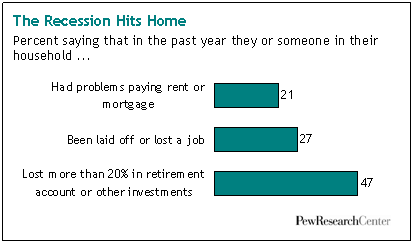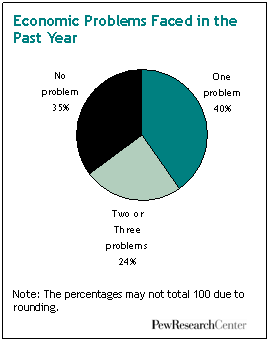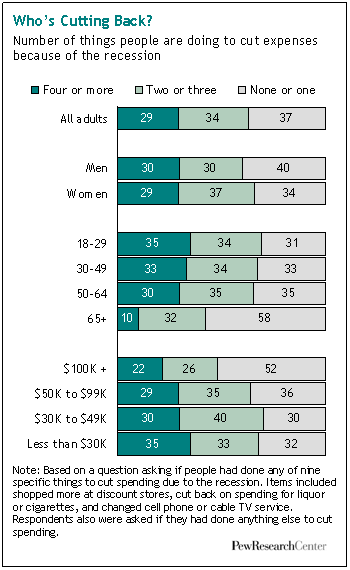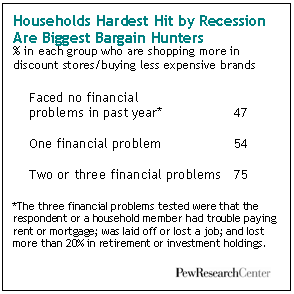IV. Who’s Been Hardest Hit by the Recession?
The survey documents a range of ways the recession has affected the economic lives of different groups of Americans. When asked about three major recession-related problems, nearly half (47%) of respondents report they or someone in their household has lost more than 20% in a retirement account or other investments in the past 12 months.

Fully a quarter (27%) report they or someone in the household has been laid off or lost a job. And 21% say they or someone in the household has had trouble paying the rent or mortgage.

When these responses are analyzed together, the full impact of the economic downturn comes into focus: Overall, about two-thirds of all American households have faced at least one of these three recession-related problems in the past year. Four-in-ten experienced one problem, while nearly one-in-five faced two, and 6% report their household faced all three of the problems tested in the survey.
The survey also finds that the recession has affected different demographic groups in different ways, with young people, women and the less affluent more likely than older adults, men or wealthier households to experience job loss or have problems paying their mortgage or rent. By contrast, middle-aged adults as well as more affluent families are more likely than other groups to say they or a member of their household has lost substantial portions of their investment portfolios.
Those hurt most by the recession also are the most likely to have taken specific steps to cut back on spending. But economic hard times had no impact on ratings of individual items as luxuries or necessities: Those who had experienced the three recession-related problems tested in the survey were no more likely than those who have not yet faced these financial shocks to say that a microwave, clothes dryer, air conditioning or TV were luxuries rather than necessities.
Those Hurt by Recession Most Likely to Cut Back

To measure how the recession has affected attitudes and behaviors related to spending and thrift, two scales were created and then analyzed together. The first scale was based on responses to the questions asking people if they or a household member had lost more than 20% of their retirement or investment holdings; had difficulty paying their mortgage or rent; or had lost their job or were laid off. A second scale was based on the series of questions that measured how many things people were doing to save money as a result of the recession. The cost-cutting steps ranged from shopping more at discount stores to doing their own home repairs to growing a vegetable garden. Fully 29% of all adults had cut expenses in four or more of the ten ways measured in the survey, while 34% had cut back in two or three ways and 38% had saved money in none or just one.
Not surprisingly, those most affected by the recession have done the most to save money.
Overall, about half of those who reported they or someone in their households faced two or all three of the financial problems in the past year cut back in at least four areas. That’s more than double the proportion among those who experienced none of the problems (51% vs. 20%).

example, three-quarters of those who reported their household faced at least two of the tested problems say they are shopping more at discount stores or buying less expensive brands. That compares with less than half (47%) of those who had experienced none of the three problems in the past 12 months. Those facing multiple recession-related difficulties also are three times as likely to say they have moved in with someone or had someone move in with them than are respondents who faced none of the problems (22% vs. 7%). Similarly, those who have had to deal with multiple problems are twice as likely to say they held a garage sale or sold items on the Internet (28% vs. 12%).
However, experience with recession-related problems has little or no correlation with public perceptions of common consumer goods as necessities or luxuries. For example, virtually identical proportions of respondents rated a microwave as a necessity, regardless of whether respondents report their households had experienced none of the three problems (46%) or at least two of the problems (48%). Similarly, 65% of those who have experienced none of the tested problems and 66% of those who have faced at least two rate a clothes dryer as a necessity.




